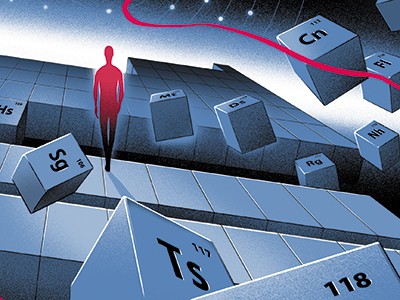
The periodic table is a powerful symbol of science past, but can also point to the future.Credit: Sean Gallup/Getty
At first glance, the system of chemical elements published by Dmitri Mendeleev in 1869 bears little resemblance to the modern periodic table. But by listing elements in columns, and lining up the columns to place elements that have similar properties along the same row, he laid the foundations for the iconic arrangement of elements that we know today. To recognize the 150th anniversary of Mendeleev’s achievement, the United Nations declared 2019 to be the International Year of the Periodic Table of Chemical Elements (although the modern version was conceived in the 1940s). Nature is joining in the celebration this week, with a special issue on what is perhaps the most famous chart in science.
Nature special: The periodic table
Although Mendeleev has the name recognition, he was not the first to try to organize the elements into a meaningful chart with a pattern that repeats on the basis of similar physical or chemical characteristics. In 1862, the French geologist Alexandre-Émile Béguyer de Chancourtois was the first to recognize a periodicity in the elements, and he plotted their atomic weights in a screw-like fashion around the outside of a cylinder. Others, including the English chemist John Newlands and the German chemist Julius Lothar Meyer also published versions of the periodic table before their Russian counterpart. Mendeleev’s system gained widespread attention in the scientific community, however, when the discoveries of gallium, scandium and germanium filled gaps in his original table, confirming its power as a predictive tool and proving that it was more than just a chemical catalogue.
Today, there are 118 confirmed elements, neatly ordered according to atomic number — the number of protons found in the nucleus of each element. The periodicity in the properties of the elements, and therefore the fundamental shape of the table, stems from the way in which electrons fill discrete energy levels in the atoms of any given element. Considering that it would be many years before electrons and protons were discovered and the structure of the atom unravelled, Mendeleev’s achievement seems all the more impressive.
The periodic table not only contains all of the atomic building blocks found so far, but also provides a framework for future finds. When the four most recent additions to the table (the synthetic elements nihonium, moscovium, tennessine and oganesson) were formally recognized in 2016, the remaining gaps on the bottom row were finally filled. This could give the impression that Mendeleev’s masterpiece is finally complete, but the search for element 119 — which would be the first in a brand new row — is already under way in some laboratories, including at the RIKEN Nishina Center for Accelerator-Based Science in Saitama, Japan. Its director, Hideto En’yo, predicted in 2017 that elements 119 and 120 would both be found within five years; the clock is ticking. Meanwhile, research on the existing superheavy elements might change the periodic table, too.
As an educational tool and a research aid, the table is often found adorning the walls of classrooms or the inside covers of chemistry textbooks. At a fundamental level, it is simply a reference work that can provide, for example, the atomic weight of sulfur or the less-than-obvious symbol for an element that might have slipped the mind: see if you can remember the symbol for antimony, for example, or tungsten. But delve a little more deeply into its history and development, as well as the people and places it immortalizes, and the periodic table tells some fascinating stories of how science has become inextricably linked with society over the past 150 years.
The table has permeated many aspects of our culture, from the writing of Primo Levi to Tom Lehrer’s song ‘The Elements’ (brought up to date in 2016 by Helen Arney). It’s printed on ties, T-shirts, lunchboxes, shopping bags and more. The table has been widely borrowed, doctored and used to categorize everything from varieties of alcohol to zombie-killing weapons.
Although its scientific underpinning has been somewhat lost in the translation to popular culture, there is clearly something about the periodic table that resonates with a wider audience. Chemists should seek to tap into this fascination in the year ahead, and highlight the importance of the original and still the best — the one that corrals all of the known atomic building blocks of the Universe into an orderly array.

 Extreme chemistry: experiments at the edge of the periodic table
Extreme chemistry: experiments at the edge of the periodic table
 Can quantum ideas explain chemistry’s greatest icon?
Can quantum ideas explain chemistry’s greatest icon?
 Celebrate the women behind the periodic table
Celebrate the women behind the periodic table
 More than 2,000 years of elements: a prehistory of the periodic table
More than 2,000 years of elements: a prehistory of the periodic table
 In his element: looking back on Primo Levi’s The Periodic Table
In his element: looking back on Primo Levi’s The Periodic Table
 The first synthetic element
The first synthetic element
 Futures SF: Elementary school
Futures SF: Elementary school


